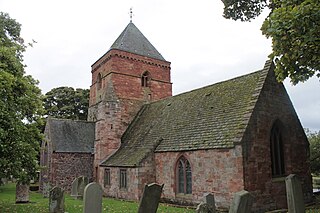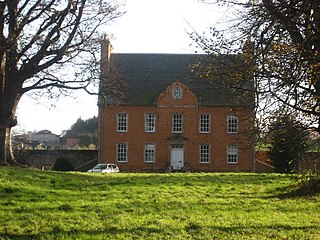
The Rev. John Kerr FRSE LLD (1852-1920) was a Scottish minister, sportsman and sports author. He has been titled the Sporting Padre. [1] His sporting repertoire included golf, curling, and skating.

The Rev. John Kerr FRSE LLD (1852-1920) was a Scottish minister, sportsman and sports author. He has been titled the Sporting Padre. [1] His sporting repertoire included golf, curling, and skating.
He was born in Trohoughton in Dumfriesshire on 29 May 1852, one of eleven children to David K. Kerr and his wife, Mary Bell. He was educated locally at the Glencairn School in Dumfries.
He studied divinity and graduated MA, probably at Glasgow University. His first post was as minister of Skelmorlie Church in North Ayrshire. In 1878 he transferred to Dirleton Kirk in East Lothian, where he remained for the rest of his life.
In 1892 he was elected a fellow of the Royal Society of Edinburgh. His proposers were Sir Andrew Douglas Maclagan, George Baillie-Hamilton-Arden, 11th Earl of Haddington, Charles Alfred Cooper, and H. A. Webster. He resigned in 1909. [2] He served as historian to the Royal Caledonian Curling Club.
He died in Haddington on 8 December 1920.
He was married to Maria Groves in Lewisham on 17 July 1883. Their children included Alec Seton Kerr, John Randolph Kerr, and daughters, Edith Katherine, Constance Ursula, Marie and Winifred Violet.

East Lothian is one of the 32 council areas of Scotland, as well as a historic county, registration county and lieutenancy area. The county was called Haddingtonshire until 1921.
John Kerr may refer to:

The Royal Burgh of Haddington is a town in East Lothian, Scotland. It is the main administrative, cultural and geographical centre for East Lothian. It lies about 17 miles east of Edinburgh. The name Haddington is Anglo-Saxon, dating from the sixth or seventh century AD when the area was incorporated into the kingdom of Bernicia. The town, like the rest of the Lothian region, was ceded by King Edgar of England and became part of Scotland in the tenth century. Haddington received Burgh status, one of the earliest to do so, during the reign of David I (1124–1153), giving it trading rights which encouraged its growth into a market town.

David Welsh FRSE was a Scottish Presbyterian minister and academic. He was Moderator of the General Assembly of the Church of Scotland in 1842. In the Disruption of 1843 he was one of the leading figures in the establishment of the Free Church of Scotland.

George Baillie-Hamilton-Arden, 11th Earl of Haddington,, was a Scottish landowner and Scottish representative peer.

Gifford is a village in the parish of Yester in East Lothian, Scotland. It lies approximately 4 miles (6.4 km) south of Haddington and 25 miles (40 km) east of Edinburgh.

Whitekirk is a small settlement in East Lothian, Scotland. Together with the nearby settlement of Tyninghame, it gives its name to the parish of Whitekirk and Tyninghame.

The Collegiate Church of St Mary the Virgin is a Church of Scotland parish church in Haddington, East Lothian, Scotland.

Hew Scott (1791–1872) was a minister of the Church of Scotland parish of Anstruther Wester. He is largely remembered as a religious researcher and author. His "magnum opus" is the comprehensive, multi-volume work, Fasti Ecclesiae Scoticanae: The succession of ministers in the parish churches of Scotland, from the reformation, A.D. 1560, to the present time. This is a detailed, biographical record of each of the ministers of each of the parishes of the Church of Scotland from 1560 to 1870.. It was first published between 1866 and 1871 but it is regularly updated by the Church of Scotland.

Bankton House is a late 17th-century house situated south of Prestonpans in East Lothian, Scotland. The house is located between the A1 road and the East Coast Main Line railway at grid reference NT394736.
George Baillie-Hamilton, 12th Earl of Haddington, was a Scottish peer from 1917 to 1986.
Alexander Handyside Ritchie was a Scottish sculptor born in Musselburgh in 1804, the son of James Ritchie, a local brickmaker and ornamental plasterer, and his wife Euphemia. The father in turn was the son of a fisherman and amateur sculptor.

Robert Walker FRSE was a Church of Scotland minister, best known as the subject of the oil painting The Skating Minister by Henry Raeburn.
John Gray was an Episcopalian minister of the Church of Scotland. In 1689, he 'became a non-juror'. as part of the schism following the Glorious Revolution. Upon his death his 'valuable library' was 'bequeathed to the Town of Haddington' which is now at the National Library of Scotland having been deposited there in 1961.
The Sheriff of Haddington, or Sheriff of East Lothian, was historically the royal official responsible for enforcing law and order in Haddington, Scotland. Prior to 1748 most sheriffdoms were held on a hereditary basis. From that date, following the Jacobite uprising of 1745, the hereditary sheriffs were replaced by salaried sheriff-deputes, qualified advocates who were members of the Scottish Bar.

Angus Makellar (1780–1859) was a Scottish minister of the Church of Scotland who served as Moderator of the General Assembly of the Church of Scotland in 1840. Leaving in the Disruption of 1843 he also served as Moderator of the General Assembly of the Free Church of Scotland in 1852.
John Mortland or Morthland of Rindmuir FRSE (1751–1807) was a Scottish advocate who was one of the joint founders of the Royal Society of Edinburgh in 1783.
Walter Young FRSE was an 18th/19th century Scottish minister of the Church of Scotland remembered primarily as a musician and collector of Scottish songs. He was an influence on Robert Burns.
George Hamilton (1757–1832) was a Church of Scotland minister who served as Moderator of the General Assembly in 1805.

Robert Lorimer was a Presbyterian minister who served in Haddington. After nearly 50 years in the Church of Scotland ministry he walked out during the schism known as The Disruption and joined the Free Church of Scotland.